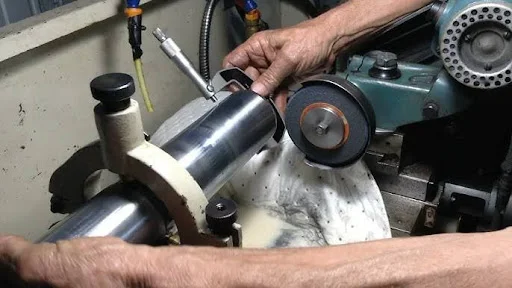Chapter 8: Machine Shop Estimation – Grinding
.
Operations
8.1 Introduction
Grinding is a precision machining process that uses an abrasive wheel as the cutting tool. It is commonly used in finishing operations where tight dimensional tolerances and high surface quality are required. Grinding is crucial in achieving the final dimensions and smoothness of components, especially those used in high-performance applications.
This chapter focuses on estimation procedures related to grinding operations, including types of grinding, process parameters, time estimation, cost estimation, and example calculations.
8.2 Objectives of Grinding Operation
-
Achieve precise dimensions and close tolerances
-
Improve surface finish
-
Remove small amounts of material to eliminate errors from prior operations
-
Prepare surfaces for heat treatment or coating
8.3 Types of Grinding Operations
Grinding operations can be broadly classified into the following:
8.3.1 Surface Grinding
-
Removes material from flat surfaces.
-
Workpiece held on a magnetic chuck or fixture.
-
Movement of the table is linear.
8.3.2 Cylindrical Grinding
-
Used for external surfaces of cylindrical objects.
-
Types include:
-
External cylindrical grinding
-
Internal cylindrical grinding
-
8.3.3 Centerless Grinding
-
The workpiece is not held between centers.
-
Suitable for mass production and cylindrical parts.
8.3.4 Tool and Cutter Grinding
-
Sharpens tools like milling cutters, reamers, drills, etc.
8.3.5 Special Grinding
-
Includes gear grinding, thread grinding, and form grinding.
8.4 Parameters Affecting Grinding Estimation
Grinding involves multiple parameters that influence time, cost, and quality. Key parameters include:
-
Grinding wheel speed (N)
-
Workpiece speed (v)
-
Feed rate (f)
-
Depth of cut (d)
-
Length of the workpiece (L)
-
Number of passes required
-
Over-travel and approach allowances
8.5 Estimation of Grinding Time
8.5.1 Formula for Time Estimation in Surface Grinding:
Where:
-
= Time required (minutes)
-
= Length of workpiece (mm)
-
= Width of workpiece (mm)
-
= Allowance for over-travel (typically 5 to 10 mm)
-
= Number of passes
-
= Table speed (mm/min)
-
= Feed per stroke (mm)
8.5.2 Formula for Time Estimation in Cylindrical Grinding:
Where:
-
= Diameter of workpiece (mm)
-
= Length of workpiece (mm)
-
= Number of passes
-
= Work speed (mm/min)
-
= Feed per revolution (mm/rev)
8.5.3 Factors in Determining Number of Passes
8.6 Estimation of Grinding Cost
Total cost of grinding includes:
a) Direct Costs
-
Machine hourly rate (includes depreciation, maintenance, power)
-
Labor cost
-
Abrasive wheel cost
b) Indirect Costs
-
Setup time
-
Inspection and measurement
-
Coolant and lubricant use
Cost Estimation Formula:
Where:
-
= Machining time (hours)
-
= Machine hourly rate
-
= Labor hourly rate
-
= Cost of grinding wheel usage
8.7 Example Problems
Example 1: Surface Grinding Time Estimation
Given:
-
Length of workpiece = 120 mm
-
Width of workpiece = 60 mm
-
Over-travel = 10 mm
-
Table speed = 10,000 mm/min
-
Feed per stroke = 3 mm
-
Total material to be removed = 0.2 mm
-
Depth of cut per pass = 0.05 mm
Solution:
-
Number of passes = 0.2 / 0.05 = 4
-
-
minutes
Answer: Grinding time = 1.21 minutes
Example 2: Cylindrical Grinding Time Estimation
Given:
-
Workpiece diameter = 50 mm
-
Length = 150 mm
-
Work speed = 30 mm/min
-
Feed per rev = 0.2 mm
-
Material to be removed = 1 mm
-
Depth of cut per pass = 0.25 mm
Solution:
-
Number of passes = 1 / 0.25 = 4
-
minutes
Answer: Grinding time ≈ 15.7 minutes
8.8 Common Allowances in Grinding
-
Over-travel Allowance: 5–10 mm depending on workpiece shape
-
Approach Distance: 5–15 mm to ensure full contact
-
Grinding Allowance: 0.1–0.5 mm generally provided for finishing
8.9 Advantages of Accurate Grinding Estimation
-
Better control over production scheduling
-
Reduced waste of material and abrasives
-
Cost-effective machining process
-
Improved resource allocation
8.10 Limitations of Grinding Estimation
-
Actual grinding may vary due to machine condition and operator skill
-
Difficult to estimate wear rate of abrasive wheels
-
Coolant effects and thermal distortions may not be included
-
Surface finish and dimensional accuracy influence real-time outcomes
8.11 Safety and Best Practices in Grinding
-
Use guards and personal protective equipment (PPE)
-
Avoid excessive force; let the wheel do the cutting
-
Check wheel balance and dressing regularly
-
Ensure proper coolant flow
8.12 Conclusion
Grinding operations are critical for high-precision finishing and must be accurately estimated to control costs and ensure timely delivery. This chapter has presented fundamental estimation methods, important parameters, formulas, and example calculations. Proper understanding and application of grinding estimation principles improve the efficiency and economy of machine shop operations.
8.13 Exercises
-
Define surface grinding and explain its applications.
-
Calculate the grinding time for a 200 mm × 80 mm plate with 5 passes, table speed of 12,000 mm/min, feed per stroke of 2 mm, and over-travel of 10 mm.
-
Explain the difference between cylindrical and centerless grinding.
-
Estimate the cost of a grinding operation lasting 20 minutes, with a machine rate of ₹400/hr, labor cost ₹200/hr, and grinding wheel cost ₹50.
-
Discuss at least three factors that affect grinding time estimation.

Comments
Post a Comment
"Thank you for seeking advice on your career journey! Our team is dedicated to providing personalized guidance on education and success. Please share your specific questions or concerns, and we'll assist you in navigating the path to a fulfilling and successful career."